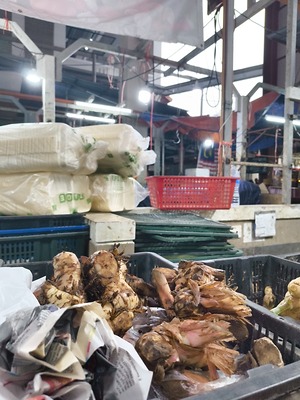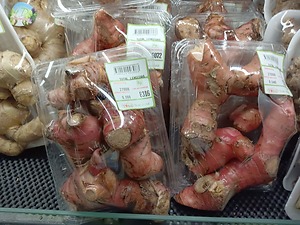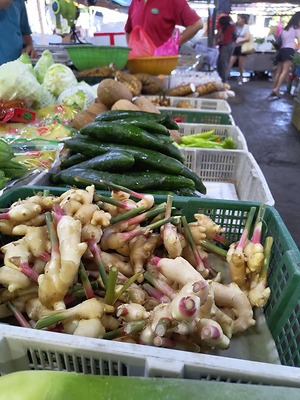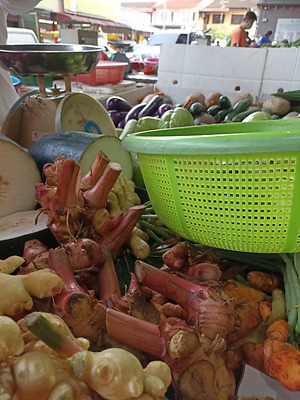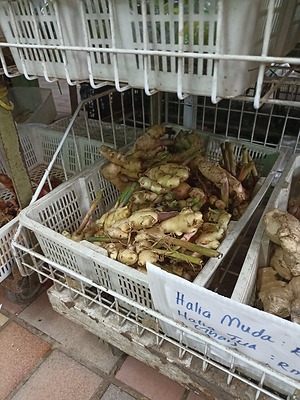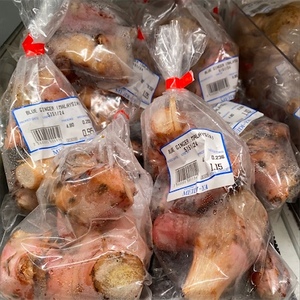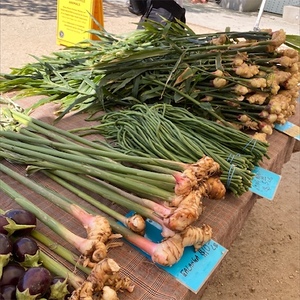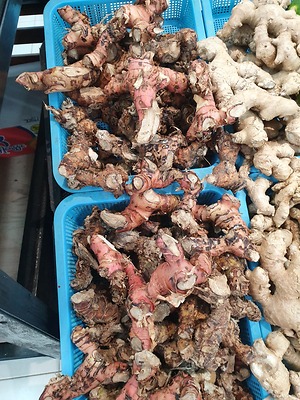Young Galangal consists of the bright white, smooth, almost shiny rhizome with pink shoulders where the stems grow from the bulb. The entirely edible plant is very in similar appearance to fresh ginger with leaves. The plant is harvested when it reaches between one and three feet in height, which is only about a third of its mature height. The young rhizome and stalks impart a subtle Galangal spiciness but still retain a robust citrus and earthy flavor. It is full of oil, aromatic and flavorful. The mature root, referred to as “Old Galangal” is harvested at least a year later.
Young Galangal, also known as Kha Oon in Thailand, is a member of the Zingiberaceae family. The harvested plant is the immature root and stem of the better known Galangal rhizome. It is related to ginger and is used as an aromatic in Thai and Asian cuisine.
Galangal is revered in Ayurvedic medicine. It is used as a digestive stimulant, to settle an upset stomach and ease nausea and flatulence.
Young Galangal, both the small rhizome, stem and leaves are used. The plant is used much like lemongrass as an aromatic. Young Galangal is most common in Thai cuisine and is called for in recipes for soups like Tom Yum and Tom Kha, Thai curry paste and fish dishes. Galangal is considered a “de-fisher” and is often used in fish dishes to tone down the stronger flavors of some fish. To prepare stems, any reddish brown portion is peeled off to reveal the tender young shoot beneath. The fibrous green stalk and large, elongated, blade-like leaves can be used to make juice, infuse curries, sauces and steeped to make tea. Young Galangal can be kept in the refrigerator for a few days before it begins to wilt.
Young Galangal is often found in dishes throughout Phuket, an island in southern Thailand. It is used in a sour soup called Tom Som Kha Oon made with both banana and Young Galangal stems. The older root has a history in medieval Europe, during which period it was known as "galingale” and it had wide use as a spice and aphrodisiac.
Young Galangal is native to the grasslands of Southern China and Southeast Asia. Young Galangal is foraged, grown by home cooks and cultivated on plantations and is commonly found in markets throughout Thailand, Malaysia and Java in Southeast Asia.
Young Galangal Roots
12/08/2024
View Notes
Young Galangal features a bright white, smooth rhizome with pink shoulders and has a striking resemblance to fresh ginger. It is harvested when it reaches one to three feet tall, about one-third of its mature height. With a subtle spiciness, its citrus and earthy flavors remain robust. The plant is aromatic, oil-rich, and highly flavorful, while the mature version, "Old Galangal," is harvested at least a year later.
Young Galangal Roots
10/14/2024
View Notes
Young Galangal is a versatile aromatic ingredient popular in Thai cuisine. It is used in dishes such as Tom Yum soup, Tom Kha soup, Thai curry paste, and fish recipes to balance stronger fish flavors. The reddish-brown portions on the stems are peeled off to reveal tender shoots. Its leaves and fibrous stalks can be juiced, infused in curries or sauces, or steeped for tea, but it wilts after a few days in the refrigerator.
Young Galangal Roots
02/02/2024
View Notes
Galangal: Young Galangal, also called Kha Oon in Thailand, is the immature root and stem of the Galangal rhizome, which belongs to the Zingiberaceae family. Closely related to ginger, it serves as a fragrant addition in Thai and Asian dishes. It is valued in Ayurvedic medicine for its digestive benefits, helping to relieve stomach discomfort, nausea, and flatulence.
Young Galangal Roots
02/24/2023
View Notes
Young Galangal is a spice native to the grasslands of Southern China and Southeast Asia. It is used in traditional cooking and grows in various settings, including being foraged, grown by home cooks, and cultivated on plantations. It is widely available in markets across Thailand, Malaysia, and Java, making it a popular ingredient in Southeast Asian cuisines.
Young Galangal Roots
02/08/2023
View Notes
Young Galangal is a key ingredient in traditional Phuket cuisine in southern Thailand. It is featured in a sour soup called Tom Som Kha Oon, which combines banana and the stems of Young Galangal. Historically, the older root of Galangal, referred to as "galingale," was widely used in medieval Europe not only as a spice but also revered for its purported aphrodisiac properties.
Young Galangal Roots
01/12/2023
View Notes
Young Galangal is a smooth, shiny rhizome with bright white coloring and pink shoulders where stems grow. Harvested when it reaches one to three feet in height, it offers a milder Galangal spiciness combined with robust citrus and earthy flavors. Unlike the more pungent "Old Galangal," which is harvested after a year, Young Galangal is aromatic, flavorful, and full of natural oils, making it entirely edible.
Young Galangal Roots
02/20/2022
View Notes
Meidi-Ya Millenia Walk Singapore
9 Raffles Boulevard, #02-26 to 36, Millenia Walk, Singapore 039596
Young Galangal: Known for its aromatic properties, Young Galangal is integral to Thai cuisine, often likened to lemongrass for its versatility. Its tender shoot is revealed by peeling the reddish brown exterior, while its fibrous green stalk and blade-like leaves enhance juices, teas, curries, and sauces. It helps subdue strong fish flavors, earning the nickname “de-fisher.” Stored in a refrigerator, it stays fresh for several days before wilting.
Young Galangal Roots
10/02/2021
View Notes
Fresno Evergreen
Young Galangal, known as Kha Oon in Thailand, is the immature root and stem of the Galangal rhizome, belonging to the Zingiberaceae family, alongside ginger. Commonly used as an aromatic in Thai and Asian cuisine, it plays a vital role in flavoring dishes. Additionally, Galangal is highly valued in Ayurvedic medicine for its digestive stimulant properties, often helping to alleviate nausea, settle upset stomachs, and reduce flatulence.
Young Galangal Roots
09/27/2019
View Notes
Young Galangal is native to the grasslands of Southern China and Southeast Asia and is widely foraged, grown by home cooks, and cultivated on plantations. It is commonly found in markets throughout Thailand, Malaysia, and Java, reflecting its importance in local cuisines across these regions.
View Full Share Market®






